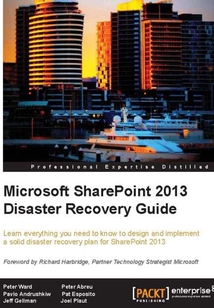首頁(yè) > 計(jì)算機(jī)網(wǎng)絡(luò) >
編程語言與程序設(shè)計(jì)
> Microsoft SharePoint 2013 Disaster Recovery Guide最新章節(jié)目錄
舉報(bào) 

會(huì)員
Microsoft SharePoint 2013 Disaster Recovery Guide
最新章節(jié):
Index
ThestyleandapproachofthebookisaneasytoreadSharePointadminguide.Thisisnotastepbystepinstructionbook,butratheraguideonhowtoimplementandexecuteadisasterrecoveryplantoyourSharePointenvironment.ThisbookisgreatforbothSharePointandSQLadministratorsnewtotheSharePoint2013architecture,andwhoarelookingtogetagoodgroundinginhowtouseimplementasoliddisasterrecoveryrecoveryplan.It'sassumedthatyouhavesomeexperienceinSharePointandWindowsServerand,aswellbefamiliarwithSQL.
目錄(109章)
倒序
- coverpage
- Microsoft SharePoint 2013 Disaster Recovery Guide
- Credits
- Foreword
- About the Authors
- About the Reviewers
- www.PacktPub.com
- Support files eBooks discount offers and more
- Preface
- Why this book
- How to start
- How to use this book
- What this book covers
- What you need for this book
- Who this book is for
- Conventions
- Reader feedback
- Customer support
- Chapter 1. Planning and Key Concepts – What Not to Forget
- Identifying DR scenarios within SharePoint and its associated technology stack
- Why disasters happen and what you can do to prevent them?
- Success or failure
- Inheriting a mission critical environment that has no DR plans
- Disaster Recovery – cost versus speed
- Thinking of interruptions and not disasters
- Four major datacenter outages in 2012 that we can learn from
- What is virtualization and how does it help with DR?
- Supporting mixed environments more efficiently with virtualized disaster recovery
- Building confidence and refining DR plans with frequent testing
- Summary
- Chapter 2. Creating Testing and Maintaining the DR Plan
- Getting started
- Identifying the components of your SharePoint environment
- Identifying threats to your SharePoint environment
- Creating an effective DR plan
- Testing your DR plan
- Maintaining your DR plan
- Further reading
- Summary
- Chapter 3. Physical Backup and Restore Procedures
- Windows Server 2012
- System database backup and restore
- Non-SharePoint database backup and restore
- Point in time backup and restore
- Advanced backup techniques
- Further reading
- Summary
- Chapter 4. Virtual Environment Backup and Restore Procedures
- Virtual environments
- Summary
- Chapter 5. Central Administration and Other Native Backup and Restore Options
- Farm backup and restore
- Farm configuration backup and restore
- Web application backup and restore
- Service application backup and restore
- Content database backup and restore
- Customizations backup and restore
- Site collection backup and restore
- Apps backup and restore
- Sites lists and libraries – backup and restore
- Summary
- Chapter 6. Working with Data Sizing and Data Structure
- Understanding data sizing architectural choices for DR
- DR impact of design decisions
- Getting a handle on a farm
- Managing growth
- Architecting data in SharePoint with DR in mind
- Further reading
- Summary
- Chapter 7. Disaster Recovery with Custom Development
- The basics
- The 3 Cs of SharePoint Development
- Accounting for things
- Change Management and SharePoint
- SharePoint 2013 App Development Model
- Summary
- Chapter 8. Disaster Recovery Techniques for End Users
- Why is end user DR training often forgotten?
- Useful end user DR practices
- Managing end user expectations
- Training
- Summary
- Chapter 9. In the Clouds
- DR – on-premise versus cloud
- DR – cloud versus cloud-native
- Common concerns regarding cloud DR
- Cloud responsibility
- General approaches to cloud DR
- Amazon Web Services and HA/DR
- Windows Azure and HA/DR
- Summary
- Chapter 10. Where to Start
- How to get my organization moving in the right direction
- How to sell DR to senior management
- I feel the SharePoint end users don't care about SharePoint DR. Is this true?
- I have written the DR plan but will it work?
- What are the key skills that are required for a DR plan to work?
- How do you write up the perfect DR documentation?
- Can this whole process be outsourced to an external party?
- Further reading
- Summary
- Appendix A. Appendix
- Worst and best practices
- Horror stories that the authors have witnessed
- How and why assumptions can sink a DR plan
- Real-world scenarios for consideration
- Useful references
- Naming conventions
- Index 更新時(shí)間:2021-04-02 10:28:19
推薦閱讀
- C語言從入門到精通(第4版)
- Hands-On RESTful Web Services with Go
- PHP+MySQL+Dreamweaver動(dòng)態(tài)網(wǎng)站開發(fā)實(shí)例教程
- JavaScript動(dòng)態(tài)網(wǎng)頁(yè)開發(fā)詳解
- 從Java到Web程序設(shè)計(jì)教程
- 機(jī)器學(xué)習(xí)與R語言實(shí)戰(zhàn)
- Android驅(qū)動(dòng)開發(fā)權(quán)威指南
- Programming with CodeIgniterMVC
- HoloLens與混合現(xiàn)實(shí)開發(fā)
- 分布式數(shù)據(jù)庫(kù)原理、架構(gòu)與實(shí)踐
- Node.js從入門到精通
- Implementing Domain:Specific Languages with Xtext and Xtend
- 程序員的英語
- Office VBA開發(fā)經(jīng)典:中級(jí)進(jìn)階卷
- 破繭成蝶:用戶體驗(yàn)設(shè)計(jì)師的成長(zhǎng)之路
- Web測(cè)試囧事
- 軟件系統(tǒng)優(yōu)化
- LabVIEW虛擬儀器設(shè)計(jì)及應(yīng)用:程序設(shè)計(jì)、數(shù)據(jù)采集、硬件控制與信號(hào)處理
- Python:Penetration Testing for Developers
- Spring:Microservices with Spring Boot
- 實(shí)用XML應(yīng)用開發(fā)技術(shù)
- Introducing Microsoft SQL Server 2019
- 深入理解Kotlin協(xié)程
- SAP Data Services 4.x Cookbook
- Android Studio 3.6 Development Essentials(Java Edition)
- Spring Boot從入門到精通
- Building a Home Security System with Arduino
- Scratch 3.0少兒游戲趣味編程2
- 使用前端技術(shù)展現(xiàn)Web系統(tǒng)(藍(lán)橋杯軟件大賽培訓(xùn)教材-Java方向)
- 硅谷設(shè)計(jì)之道:探尋硅谷科技公司的體驗(yàn)設(shè)計(jì)策略

